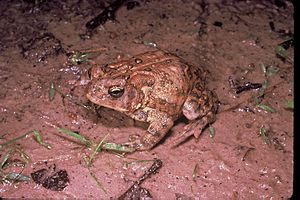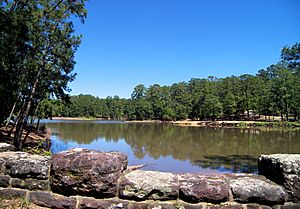Houston toad facts for kids
Quick facts for kids Houston toad |
|
|---|---|
 |
|
| Conservation status | |
| Scientific classification | |
| Synonyms | |
|
Bufo houstonensis Sanders, 1953 |
The Houston toad (Anaxyrus houstonensis) is a special kind of amphibian that is found only in Texas, United States. This toad is an endangered species, which means there are very few of them left in the wild. Scientists discovered this toad in the late 1940s, and it was officially named in 1953. Experts believe there are only about 3,000 to 4,000 adult Houston toads left today.
Contents
About the Houston Toad
Male Houston toads grow to be about 2 to 3.5 inches long. Female toads are usually bigger and heavier. Their skin is often brown and speckled, but it can also be black or purplish-gray. Sometimes, they even have green patches!
Houston toads usually live for 2 to 3 years. They dig burrows to stay safe. These burrows protect them from the cold in winter and the hot, dry weather in summer. Houston toads are nocturnal, meaning they are active at night. They hunt for insects and other small creatures to eat.
Houston Toad Reproduction and Life Cycle
In February and March, male Houston toads make a high, clear trilling sound. They do this by puffing out a special sac on their throat. This call helps them attract a female mate. Female toads choose a male based on how his call sounds.
Houston toads like to breed in small, quiet pools and ponds. A female toad can lay thousands of eggs. These eggs are laid in long, single strands. As the female lays the eggs, the male fertilizes them. The eggs hatch in about seven days. The tiny tadpoles then take between 15 and 100 days to change into small toads. Once they become toadlets, they leave the pond. They start to forage (search) for food like ants, beetles, and moths.
How Houston Toads Protect Themselves
Houston toads move by making short hops. They usually cannot outrun animals that want to eat them. These predators include snakes, turtles, large birds, raccoons, and other frogs.
To stay safe, Houston toads have developed special ways to hide. Their skin color and rough texture help them camouflage themselves. This means they blend in with their surroundings. Their skin also makes chemicals that taste bad to predators. Some of these chemicals are even poisonous. These chemicals not only protect the toad, but some have also been useful in making medicines for people. These medicines can help with heart and nerve problems.
Where Houston Toads Live
Today, the Houston toad lives only in certain areas of Texas. These areas are pine and oak woodlands. They also live in open grassy areas called savannas. These places have plants like loblolly pine, post oak, and yaupon holly.
Houston toads prefer areas with loose, sandy soils that are more than 40 inches deep. They need slow-moving or still water for breeding. These water spots must last for at least 30 days for the tadpoles to grow.
The Houston toad used to live in 12 counties in Texas. Now, they are often reported in nine counties. However, scientists have only heard their calls in three counties since the year 2000. This shows a big drop in where they live over the last twenty years.
Protecting the Houston Toad
In 1970, the Houston toad was officially listed as an endangered species by the government. They disappeared from the Houston, Texas area by the 1960s. This likely happened because of a big drought in the 1950s. Also, their forest habitat was destroyed as the city grew.
The biggest danger to the Houston toad is losing its home. But smaller toad groups are also at risk from cars, predators, pesticides, and dry weather.
The largest groups of calling toads are found in Bastrop County. However, the number of toads heard in Bastrop State Park dropped a lot in the mid-1990s. The numbers have not really recovered since then. This state park is the only public land where Houston toads consistently call each year. Even there, the total numbers are very low.
Groups that work to protect nature are helping private landowners in Bastrop County. They are working to protect and fix the Houston toad's habitat. But even if the toads recover in Bastrop County, more work is needed. Efforts are needed in other counties where the toad still lives. They are even needed in counties where the toad has disappeared.
In 2008, a plan called the Lost Pines Habitat Conservation Plan was approved. This plan describes how to manage and help the Houston toad recover in special areas of Bastrop County.
In September 2011, a huge fire called the Bastrop County Complex fire destroyed a lot of the Houston toad's home. Most of Bastrop State Park and much of the main toad habitat in central Bastrop County were badly burned. The Lost Pines Forest was heavily damaged by the fire.
The Houston Zoo has a special breeding program for the Houston toad. They have a large area where they raise toads. In 2018, they released over one million toad eggs into the wild!
See also
 In Spanish: Anaxyrus houstonensis para niños
In Spanish: Anaxyrus houstonensis para niños



